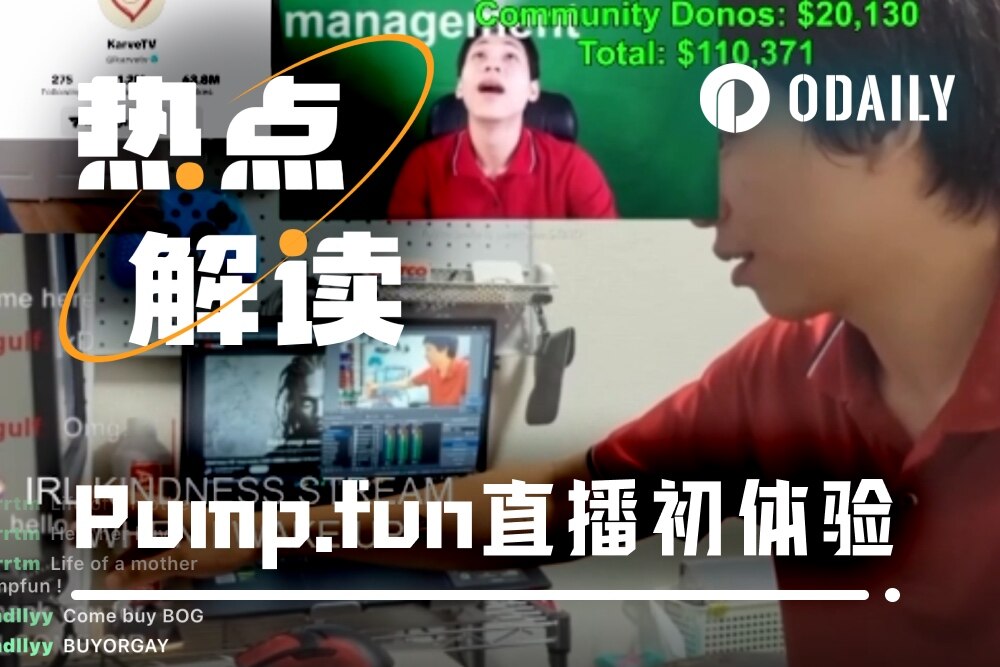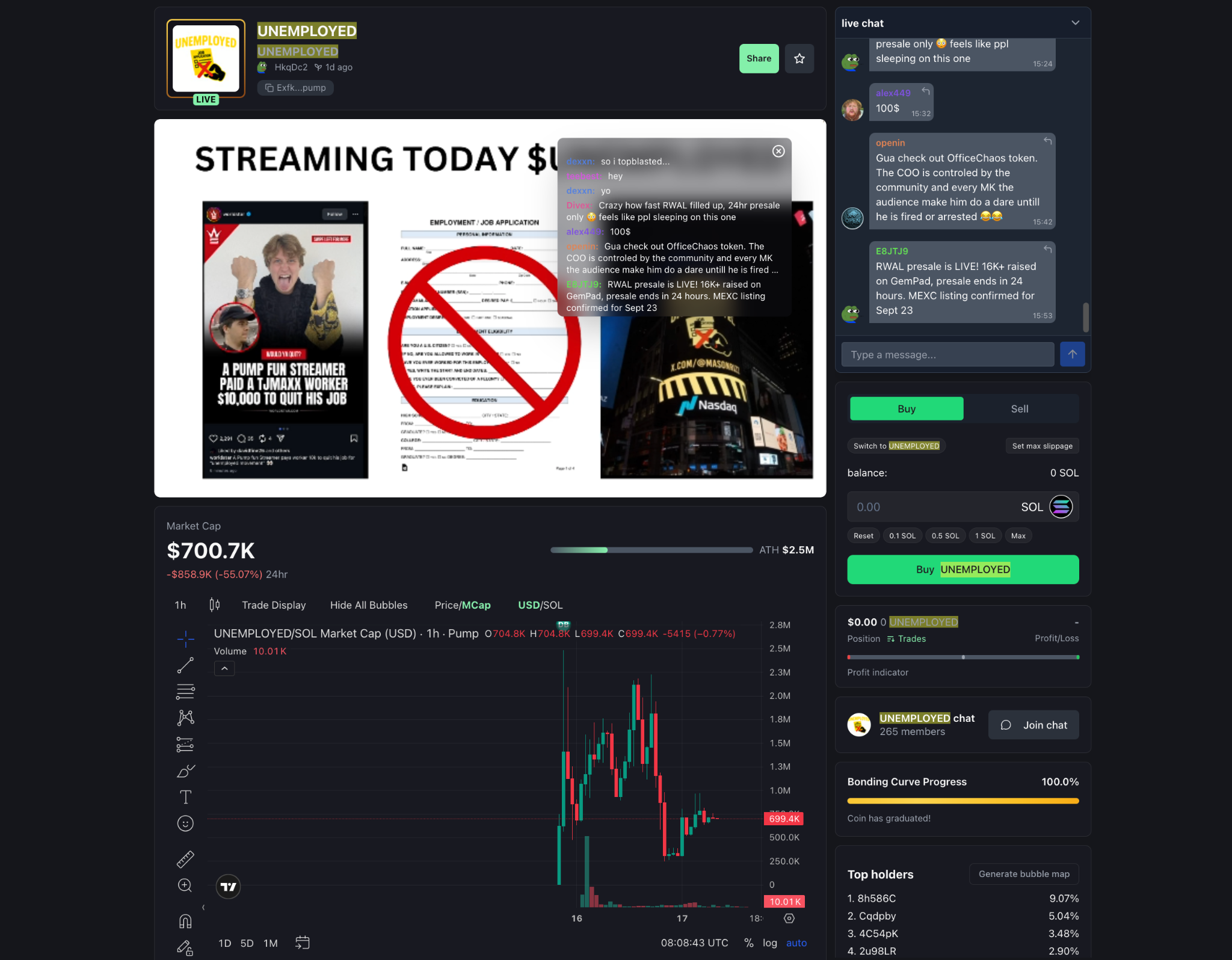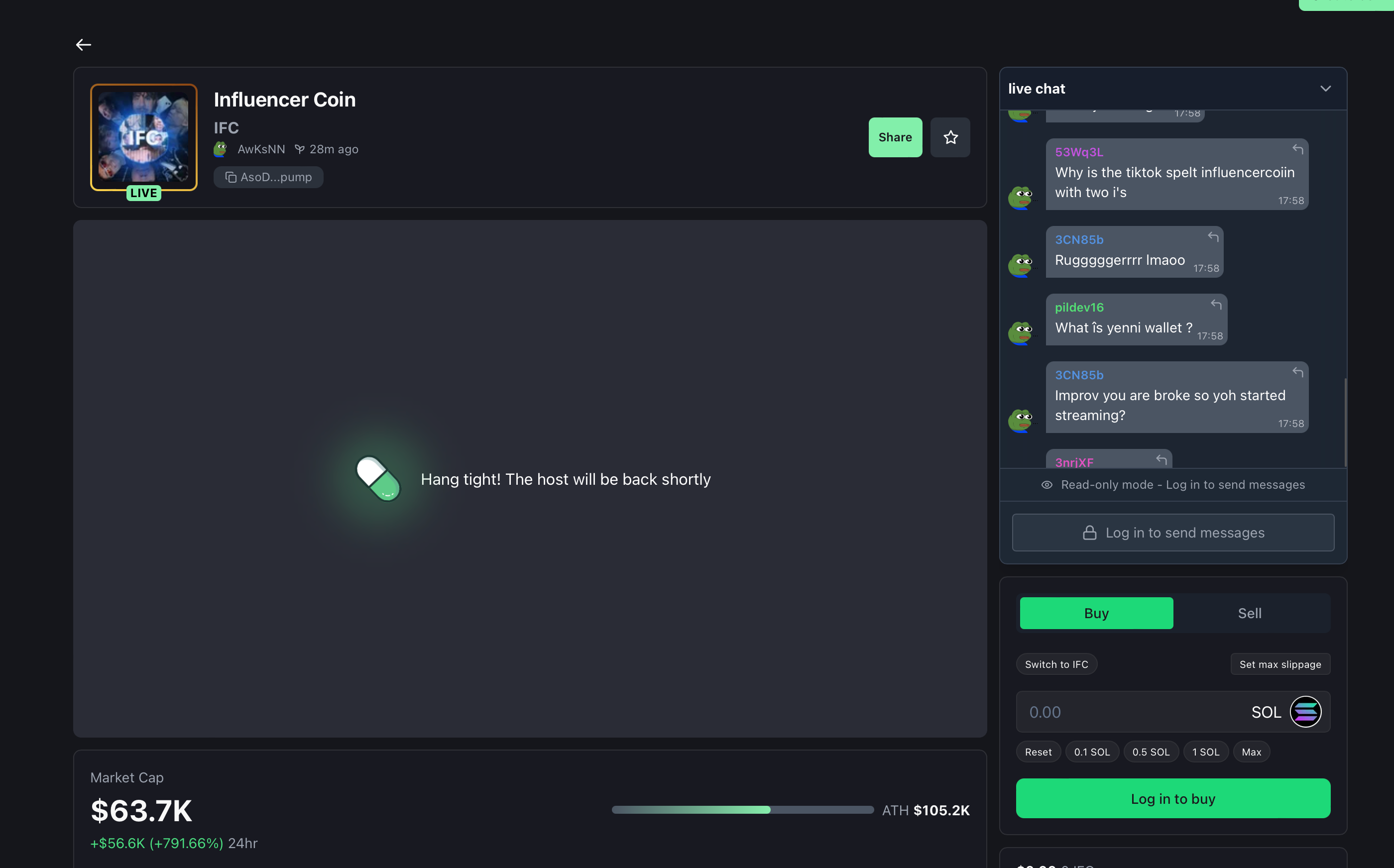Original | Odaily Planet Daily (@OdailyChina)
Author | Ethan (@ethanzhangweb3)_

In recent days, the popularity of "Pump.fun Live" has been continuously rising.
On September 14, co-founder Alon stated on X that the platform's concurrent live streams have surpassed Rumble, with a share close to 1% of Twitch and about 10% of Kick. Meanwhile, the underlying mechanism has undergone a structural transformation: Project Ascend has changed the creator revenue share from a uniform 0.05% to a dynamic rate segmented by market cap—up to 0.95% for small caps, tapering back to 0.05% as they grow, linking "attention → trading volume → streamer income" in a single chain. On September 16, the PUMP platform claimed that "over $4 million was distributed to creators yesterday, mostly to first-time creators," leading to a surge of "first-time live broadcasts" in the square.
Out of curiosity, I deeply watched and participated in the entire process of several token launches in live rooms. This time, did the stage, incentives, and content of Pump.fun Live really align?
From Homepage to Order: A Two-Minute Real-Time Experience with a "LIVE" Tag
Opening the Pump.fun official website, the homepage is already different from the early version.
What used to resemble a "rough version" of a launchpad has now been "renovated": at the top is a horizontal "Now trending" scrolling bar, with a uniform bright green LIVE label in the lower left corner of the cards to distinguish "tokens currently being live-streamed"; below is the Explore section, providing tags like Streamer Life, Challenge Grinds, Animal Antics, AI & Tech Mania, etc., where clicking any tag filters the waterfall stream into a group of tokens with the same style. The left sidebar is fixed with Home / Livestreams / Advanced / Chat, and the top right corner still prominently features Create Coin. The overall feel is more like a "live hall" rather than just a launch page.

In addition to the cover image, the cards also include key information such as market cap, 24-hour fluctuations, and a brief introduction, compressing "popularity + market data" into a readable layer. After hesitating for about ten seconds, I clicked into the UNEMPLOYED room marked with LIVE: the title line directly presents a narrative—"Turning Resignation into a Movement." Upon entering, the center features the streamer’s screen, with a whole column of trading and chat tools on the right: chat box, Buy / Sell panel, position and profit/loss bar, and below is the Bonding Curve Progress: 100% (Coin has graduated) prompt (the gameplay still follows the old tradition of "graduation"); at the bottom is a scrolling transaction flow, showing who bought how much and who is dumping, in real-time.

The most eye-catching part of the screen is a long image of the "program declaration": on the left, it states "A certain Pump.fun streamer gave a TJ Maxx employee $10,000 to quit" (for the room's narrative, not independently verified), and on the right is a job application form marked with a red prohibition sign, followed by a photo of the New York Nasdaq screen—"Resignation is Content" dramatically leaps off the screen.
Read the market first, then take action.
I first watched about 30 seconds of the readings on the right: market cap around $700,000, 24-hour change about -55%, historical high around $2.5 million; the 1-hour K-line chart fluctuated repeatedly, showing multiple rises and falls. Continuing to explore Top holders: the top few hold about 9% / 5% / 3%+, with concentration not being outrageous. These are the readings from the page at that time, only for recording the "market feel"; risk factors still need to consider contract permissions, team history, and other elements.
Meanwhile, what is the streamer doing?
He clearly understands the rhythm: first, he uses a few jokes to heat up the atmosphere, then throws out "highly participatory" commands—like "Countdown ten seconds, press Buy together," or calling out the nicknames of a few large orders to create the thrill of being named. In between, he constantly repeats two things: first, "This is not a tip; it's turning attention into an asset"; second, "There are still a few segments today, don't go away" (corresponding to the Previous streams / next show preview cards he has hanging below). Every interaction is on point, and the K-line immediately shows increased volume, with the bottom transaction bar appearing to be fast-forwarded.
Press the buy button.
The process is very short: connect Phantom → click Buy → enter 0.1 sol → confirm slippage and sign. Within seconds, my purchase appeared in the holdings bar at the bottom right, and my record flashed through the transaction flow. The entire process does not require jumping to another DEX page—watching, thinking, and placing orders are all completed on the same screen, with every joke from the streamer almost instantly reflected in the K-line and transaction flow.
The "noise" and "signal" of the bullet screen.
The bullet screen is divided into three categories: one is slogan-style spamming; another is irrelevant project "cross-room solicitation" (typical phrases include "XX presale is about to end, raised this much, going to a certain exchange"); the last category consists of a few useful reminders, such as whether it has "graduated" or whether there is community backup. For ordinary players coming for the first time, treating the third category as signals and the first two as background noise is more helpful in reducing misjudgments.
Summary: The LIVE tag binds "content that is happening" with "transactions that are happening" on the same screen. Unlike "off-screen tipping" on Twitch/Kick, here it is the parallel of reading the market and placing orders during the program. And live rooms like UNEMPLOYED, which "turn actions into topics," are naturally better at converting emotions into turnover—this is also why I dared to make a small trial position within two minutes.

Three Acts and Three Principles: Converting "Peaks of Attention" into Operable Rhythm
Over the past few nights, I have been shuttling between multiple live rooms, waiting for "explosive points" to appear. The three most common scenarios on-site: Lagging, Explosive Points, Newbie Live Streams, almost every night they take turns.
First, lagging in the live room
During peak hours, some rooms experienced delays or frame drops in the screen and order panel (local network factors cannot be ruled out). Two days ago, there was an even more extreme situation: on September 15, according to Decrypt, top KOL Alex Becker stated after starting a live broadcast on pump.fun that the platform was under severe pressure, making it difficult to maintain the live stream, and mentioned on X that if it could not be restored, he would switch to YouTube.
This is not simply "slow loading," but rather systematic pressure from the combination of front-end live streaming, matching, and on-chain confirmation. For traders, every click at peak moments is a race against slippage. On my screen, the transaction flow and bullet screen emotions are almost synchronized: once the streamer triggers the "collective action" slogan, the bottom transaction bar will refresh continuously, and the price will jump in steps.

Second, explosive points are driving prices
When the live content has "event-like" or strong interactive mechanisms, it often accompanies higher transactions and volatility. On September 15, according to Decrypt, streamer Bagwork played an unreleased song allegedly by Drake/Future during the live broadcast, causing the market cap of the meme coin to rise to about $53 million, with creator revenue of $83,410 over two days. Bagwork has recently gained popularity through a series of live events, including storming the field during a Los Angeles Dodgers game.
In the UNEMPLOYED room I entered, this coupling of "content → transactions" is also evident: actions like countdown "press Buy together," calling out large address nicknames, and throwing out next show previews leave clear ripples on the bottom K-line chart and transaction flow. At this point, the price is not "passively reflecting content," but is being driven within the content.
Third, the red envelope rain pushes "newbie live streams" to the forefront
The platform's external statement claims "over $4 million was distributed to creators yesterday, mostly to first-time creators." This aligns with what I saw in the square: a batch of "first-time live broadcasts" emerged that night, clearly focusing more on interaction and rhythm, because in the high-revenue small cap range of Project Ascend, streamers have a stronger marginal incentive for turnover. In other words, the more newbies there are, the more extravagant the program, the more intensive the turnover.
To translate the above three acts into executable levels, I have summarized three principles:
Principle One: Give yourself an "observation window" and wait for "secondary organization."
Enter the room and observe for 2–3 minutes, focusing on three things—whether the peak online count has declined, whether the first round of emotional orders has been fulfilled, and whether the streamer is organizing a second round of interaction. When secondary volume appears and the streamer maintains high-intensity interaction, then use a small amount to "dot" rather than chasing high during the first climax.
Principle Two: Change the tipping mindset to a position mindset.
In the Pump.fun live rooms, this is not about giving gifts, but about buying tradable positions. Set a maximum loss limit for each entry and a planned reduction trigger point before entering, viewing the participation funds as an "entertainment budget"; do not make additional investments outside the fund pool and do not use emotions as a reason.
Principle Three: Read three indicators to understand the opponent's motivation.
- Creator fee and market cap range: To maximize streamer earnings, during the high-revenue small cap phase, streamers are more willing to frequently create turning points to increase turnover;
- Position concentration (e.g., Top holders distribution): When concentration is high, the risk of being "pulled out" in the short term is greater;
- External traffic signals (previews, cross-platform collaborations, topic challenges): They are often precursors to transaction density.
Combining these three aspects makes it easier to judge whether a live room is "doing a show to increase volume" or " exhausting emotions."
Note: The events and data in this section come from public information and the author's personal experience and do not constitute investment advice. Please conduct thorough research (DYOR).
Conclusion
This round is not just "more lively," but a combination of mechanisms and scenarios: live streaming compresses attention into second-level traffic, and Ascend turns every turnover into cash flow for creators, forming a closed loop of "content → participation → transaction → distribution."
But the cold water is equally straightforward: as of September 17, according to OKX Wallet data, there are only 9 tokens in the Pump.fun "live concept" with a market cap > $1 million; while on September 15, GMGN reported 39 such tokens. The leading token Bagwork peaked at over $50 million in market cap, now around $8 million, a drop of 80%; the current highest market cap is KIND, approximately $16.8 million.
This may indicate that "turning visibility into liquidity" is valid, but the survival curve is extremely steep, with very few winners: without continuous programming and external traffic, popularity will still be quickly diluted by time and turnover.
免责声明:本文章仅代表作者个人观点,不代表本平台的立场和观点。本文章仅供信息分享,不构成对任何人的任何投资建议。用户与作者之间的任何争议,与本平台无关。如网页中刊载的文章或图片涉及侵权,请提供相关的权利证明和身份证明发送邮件到support@aicoin.com,本平台相关工作人员将会进行核查。



